Searching for Patient Profiles
The following topics provide step-by-step instructions to help you perform the various types of searches available on the Patient EDM. To move from one field to another on the search pages without using the mouse, press the Tab key. The name of the Local ID section is configurable.
-
Performing a Social Security Number Lookup on the Patient EDM
-
Performing an Advanced Alphanumeric Lookup on the Patient EDM
Performing an EUID Lookup on the Patient EDM
To search for a patient profile using only a patient’s EUID, you need to enter the EUID number in the EUID Search section of the Simple Person Lookup page. This type of search should result in only one matching profile.
Figure 6 Simple Person Lookup Page

 To Perform an EUID Lookup
To Perform an EUID Lookup
-
On the Person Search page, select Simple Person Lookup from the Search Types drop-down list.
-
In the Enterprise Unique ID section, enter the patient’s EUID.
-
Click Search or press Enter to initiate the search.
The View/Edit page appears, displaying detailed information about the patient whose EUID you entered.
Performing a Social Security Number Lookup on the Patient EDM
To search for a patient profile using only the patient’s social security number, use the SSN section of the Simple Person Lookup page (see Figure 6). While this type of search should result in only one matching profile, there might be multiple resulting profiles.
 To Perform a Social Security Number Lookup
To Perform a Social Security Number Lookup
-
On the Person Search page, select Simple Person Lookup from the Search Types drop-down list.
The Simple Person Lookup page appears (see Figure 6).
-
In the SSN section, enter the social security number of the patient you want to find.
-
Click Search or press Enter to initiate the search.
If there are multiple matching profiles, the Search Result page appears with a list of matching profiles. If there is only one matching profile, the Search Result page is bypassed, and the View/Edit page appears.
Performing a Local ID Lookup on the Patient EDM
To search for a patient profile by their local ID in a specific system, you need to enter search criteria in the Local ID section of the Simple Person Lookup page. This type of search should result in only one matching profile. If the Local ID field contains alphabetic characters, the criterion is case-sensitive.
Note –
The name of this section might have been modified for your implementation. See your system administrator for more information.
 To Perform a Local ID Lookup
To Perform a Local ID Lookup
-
On the Person Search page, select Simple Person Lookup from the Search Types drop-down list.
The Simple Person Lookup page appears (see Figure 6).
-
In the System field, enter the name of a system for which the local ID is known.
-
In the Local ID field, enter the patient's local ID in the given system.
Note –If alphabetic characters are entered in this field, the search is case-sensitive. This field name might have been modified for your implementation.
-
Click Search or press Enter to initiate the search.
The Search Result page is bypassed, and the View/Edit page appears.
Performing an Advanced Alphanumeric Lookup on the Patient EDM
To perform an advanced alphanumeric search for a patient profile, you need to specify identifying information for the patient, such as their first and last names, on the Advanced Person Lookup (Alpha) page. This type of search might result in several matching profiles.
Figure 7 Advanced Person Lookup (Alpha) Page
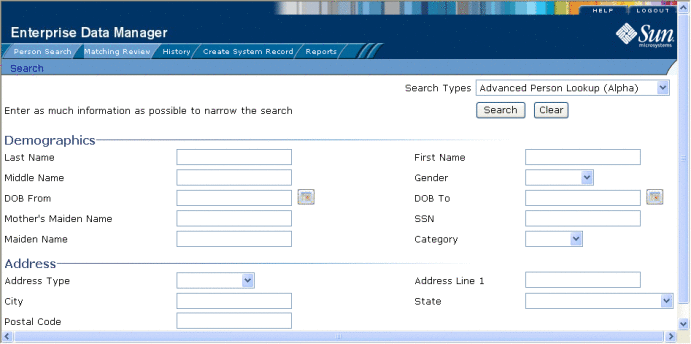
 To Perform an Advanced Alphanumeric Lookup
To Perform an Advanced Alphanumeric Lookup
-
On the Person Search page, select Advanced Person Lookup (Alpha) from the Search Types drop-down list.
-
In the Demographics and Address sections, enter search criteria for the patient you want to find (for more information, see About Alphanumeric Search Fields on the Patient EDM).
-
Click Search or press Enter to initiate the search.
The Search Result page appears with a list of matching profiles. If only one matching profile is returned, the View/Edit page appears.
Note –The system administrator can choose whether to display the EUID field or the local ID and system fields on this page. Any values entered into these optional fields take precedence over information entered into other search fields. For example, if an invalid EUID is entered but valid first and last names are entered, no results are returned due to the invalid EUID. The EUID field takes precedence over the local ID and system fields.
About Alphanumeric Search Fields on the Patient EDM
The alphanumeric search fields, located in the Demographics and Address sections of the Advanced Person Lookup (Alpha) page, allow you to specify search criteria for the patient you want to find. You should make your search as specific as possible. This type of search allows wildcard characters; use a percent sign (%) to indicate any unknown characters.
Any required fields are marked with an asterisk (*). If at least one field in group of fields is required, the fields in that group are marked with a dagger (†). This type of search supports searching by a range of values. Range searching is supported for any field type that has two fields, one with “From” appended to the name and one with “To” appended to the name (for example, “DOB From” and “DOB To”). If your Patient EDM is set up for range searching, see the system administrator for more information about how it is configured.
Note –
These fields are defined by default, but your implementation might be configured differently.
Table 3 Advanced Alphanumeric Search Fields
Performing an Advanced Phonetic Lookup on the Patient EDM
To perform an advanced phonetic search for a patient profile, you need to specify identifying information for the patient, such as their first and last names, on the Advanced Person Lookup (Phonetic) page. This search might return several profiles.
Figure 8 Advanced Person Lookup (Phonetic)
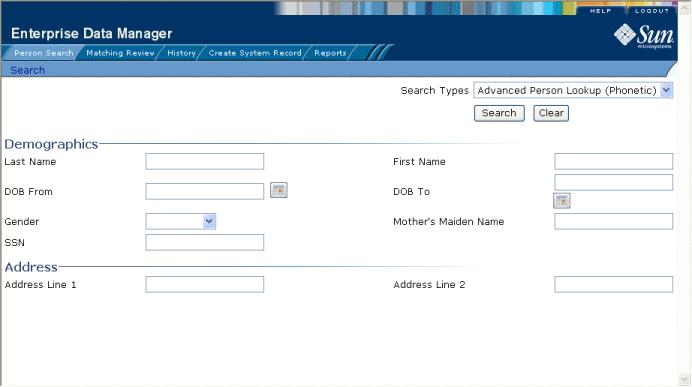
 To Perform an Advanced Phonetic Lookup
To Perform an Advanced Phonetic Lookup
-
On the Person Search page, select Advanced Person Lookup (Phonetic) from the Search Types drop-down list.
-
In the Demographics and Address sections, enter search criteria for the patient you want to find in one or more of the allowed combinations (at least one combination must be entered).
Note –By default, the following combinations are allowed:
-
First Name and Last Name
-
Address Line 1 and, optionally, Address Line 2
-
Last Name, Address Line 1, and, optionally, Address Line 2
-
Social Security Number
-
First Name, DOB, and Gender
-
Last Name and Mother’s Maiden Name
For more information about these fields, see About Phonetic Search Fields on the Patient EDM. For more information about phonetic searches, see Advanced Person Lookup (Phonetic).
The system administrator might have modified the phonetic search criteria so it is different from the above list. If you are unsure of the required criteria combinations, see your system administrator.
-
-
Click Search to initiate the search.
The Search Result page appears with a list of matching profiles. If only one matching profile is found, the results page is bypassed and the View/Edit page appears.
Note –The system administrator can choose whether to display the EUID field or the local ID and system fields on this page. Any values entered into these optional fields take precedence over information entered into other search fields. For example, if an invalid EUID is entered but valid first and last names are entered, no results are returned due to the invalid EUID. The EUID field takes precedence over the local ID and system fields.
About Phonetic Search Fields on the Patient EDM
The phonetic search fields, located in the Demographics and Address sections of the Advanced Person Lookup (Phonetic) page, allow you to specify search criteria for the patient you want to find. You should make your search as specific as possible. This type of search does not allow wildcard characters.
The Address section consists of fields that are parsed once the search is initiated. Parsed fields are separated into their various components and then standardized before the search is carried out. Parsed fields might include any of the Address Lines 1 through 4 fields, depending on how parsing is configured.
Table 4 Advanced Phonetic Search Fields
Performing an EUID Comparison Lookup on the Patient EDM
To perform a search by EUID for multiple profiles to compare, you need to specify each EUID on the Comparison Lookup page. You can enter from two to five EUIDs to compare in the search results list, and then select one or two of the resulting profiles to compare information.
Figure 9 Comparison Lookup Page
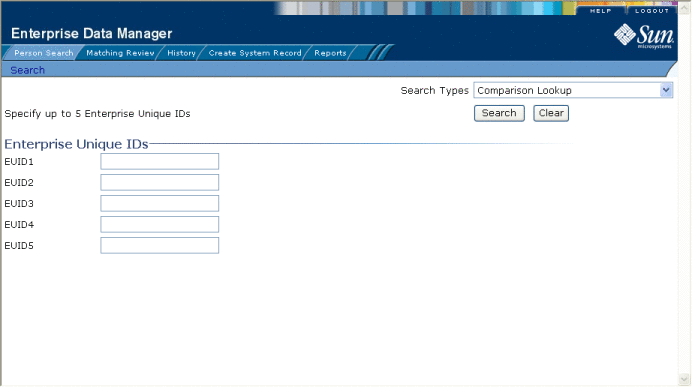
 To Perform an EUID Comparison Lookup
To Perform an EUID Comparison Lookup
-
On the Person Search page, select Comparison Lookup from the Search Types drop-down list.
-
Enter at least two, and up to five, EUIDs.
-
Click Search or press Enter to initiate the search.
The Search Result page appears with a list of matching profiles. To learn how to compare profiles, see Comparing Patient Information.
Working with Search Results on the Patient EDM
The following topics describe the Search Result page, how to sort and select the profiles that match the searches you perform, and how to print a search result report. The criteria that you entered for a search appear above the results list table on the result page.
Viewing the Results of a Search
The matching profiles that result from a patient search appear in table format on the Search Result page. The table displays a limited number of fields contained in the SBR of the patient profile.
Figure 10 Search Results List
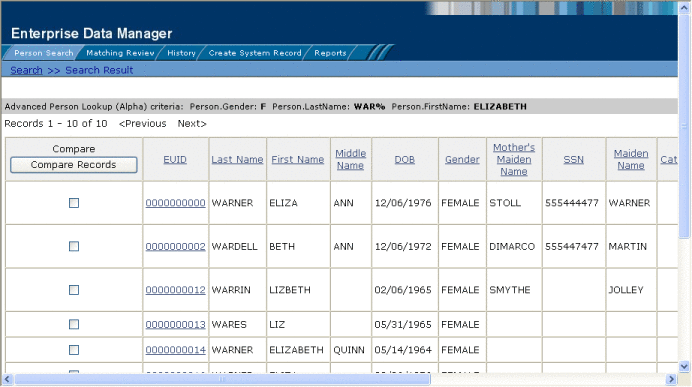
 To View the Results of a Search
To View the Results of a Search
-
Perform a search for the patient whose profile you want to access.
If more than one record matches the criteria, the Search Result page appears.
-
In the results list, view the information presented for each returned profile to determine which profile you want to view.
-
To work with search results, do any of the following:
-
To view additional address or telephone information, click the ellipsis (“...”) next to the address or telephone entry in the results list.
A popup window appears, as shown in Figure 11 and Figure 12. If there is no ellipses, there is no additional information to view.
Figure 11 Address Information Page

Figure 12 Telephone Information Page
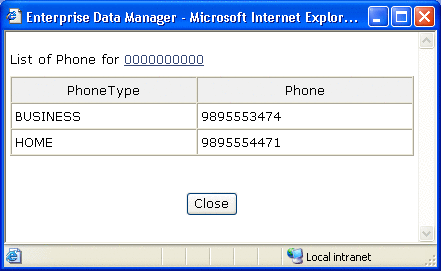
-
To view the following page of search results, click Next>.
-
To return to the previous page of results, click <Previous.
-
To sort the search results, click the column heading of the column by which you want to sort the results.
Note –Clicking a heading once sorts the profiles in ascending order; clicking the heading a second time sorts the profiles in descending order. By default, results are sorted by EUID in ascending order.
-
To view detailed information for a profile or profiles, perform any of the steps described in Selecting a Profile from the Results List.
-
To perform a new search, click New Search in the upper portion of the page.
-
To view and print the results in a report, click Print Report.
-
Selecting a Profile from the Results List
From the search results list, you can select one patient profile in order to view detailed information for that profile or you can select two patient profiles to compare the information in both profiles. You can also select one patient profile to compare different components of that profile.
 To Select a Profile to View
To Select a Profile to View
-
Perform a search for the patient profiles you want to view.
-
To view detailed information for one patient profile, click the EUID of that profile.
The View/Edit page appears, displaying the person object for that profile.
-
To compare two patient profiles, select the check boxes to the left of each profile you want to compare, and then click Compare Records.
The Comparison page appears, displaying a side-by-side comparison of the two profiles.
-
To compare different components of one patient profile, select the check box to the left of the profile you want to view, and then click Compare Records.
The Comparison page appears, displaying a side-by-side comparison of two instances of the same patient profile.
Note –Once a comparison check box is selected in the search results list, it remains checked until you clear it. If you return to the Search Result page from the Comparison page, clear the selected check boxes before making another selection.
Creating and Printing a Search Result Report
You can create a report displaying all results of a search, and then print that report to a designated printer.
Figure 13 General Search Result Report Page

 To Create and Print a Search Result Report
To Create and Print a Search Result Report
-
Perform a search for the patient profiles you want to view.
-
In the upper right portion of the Search Result page, click Print Report.
The Search Result Report page appears.
-
To print the report, click Print, and then select a printer from the Print dialog box.
Note –This reporting capability is provided on all search result pages.
- © 2010, Oracle Corporation and/or its affiliates
